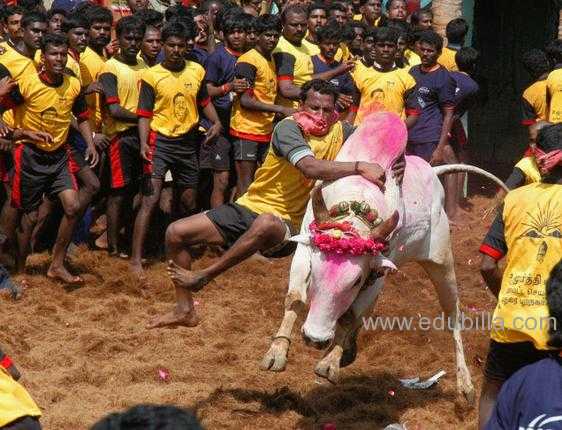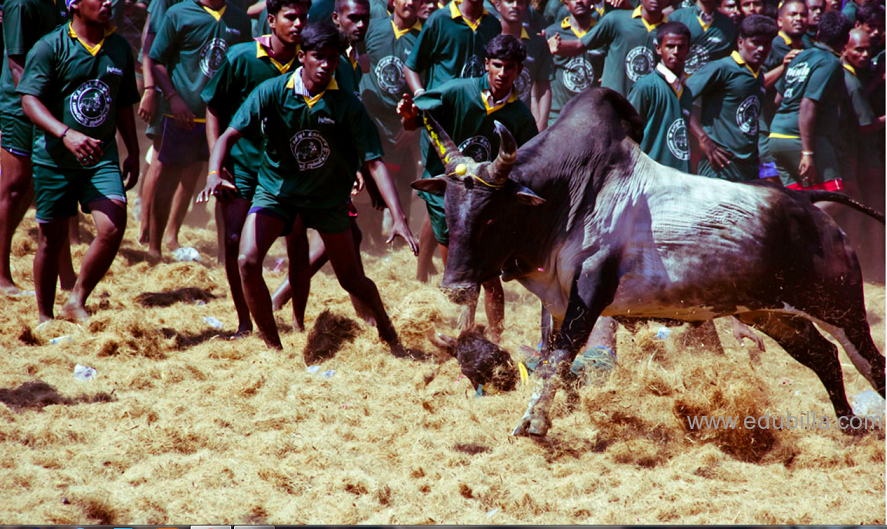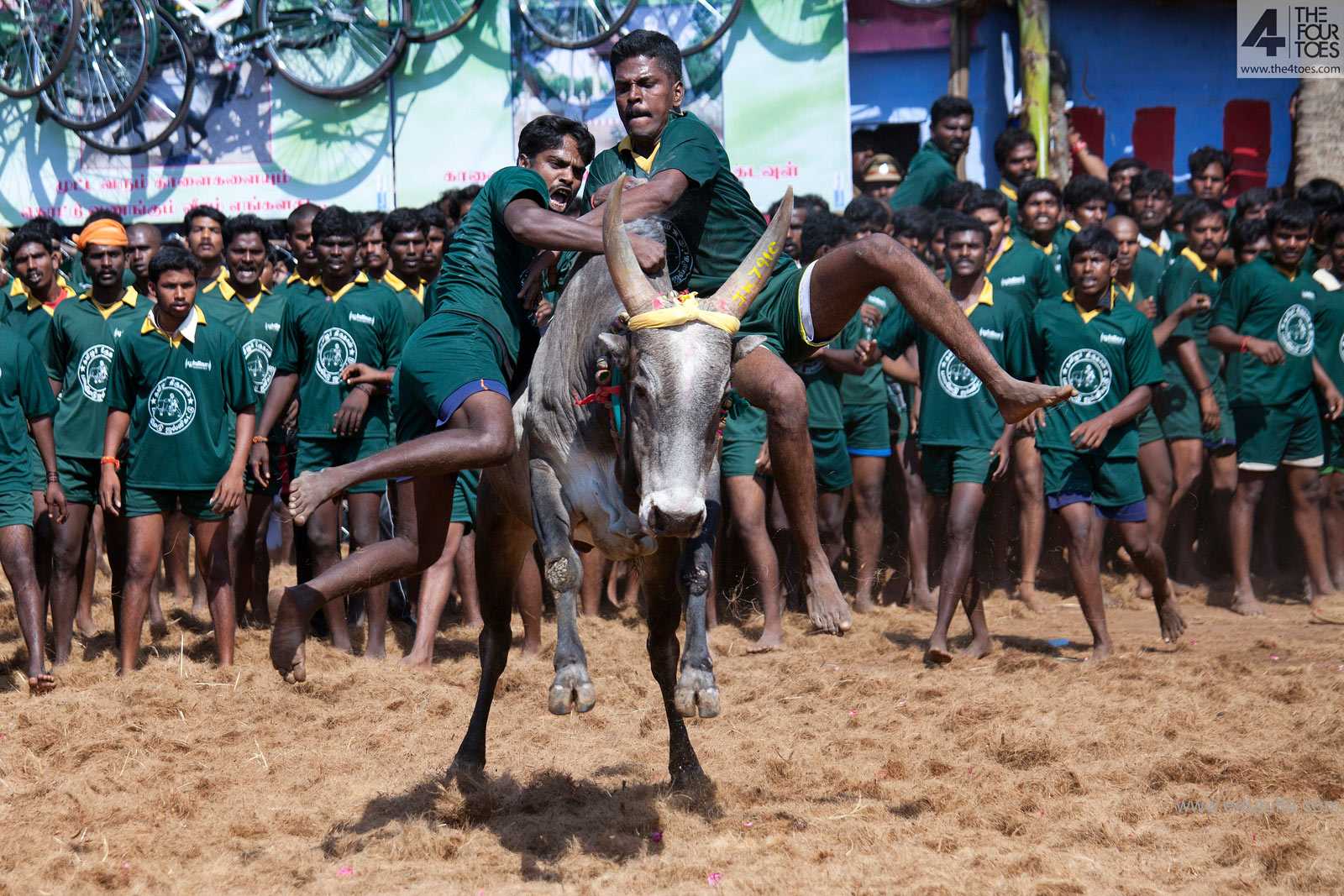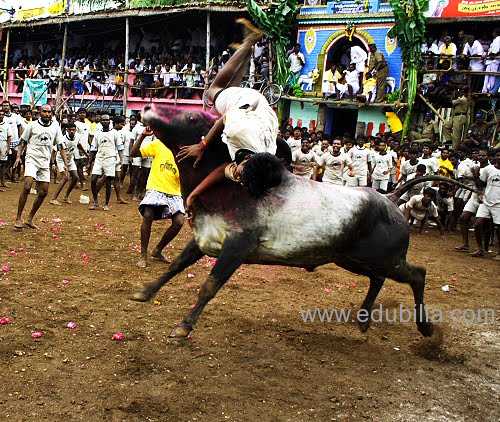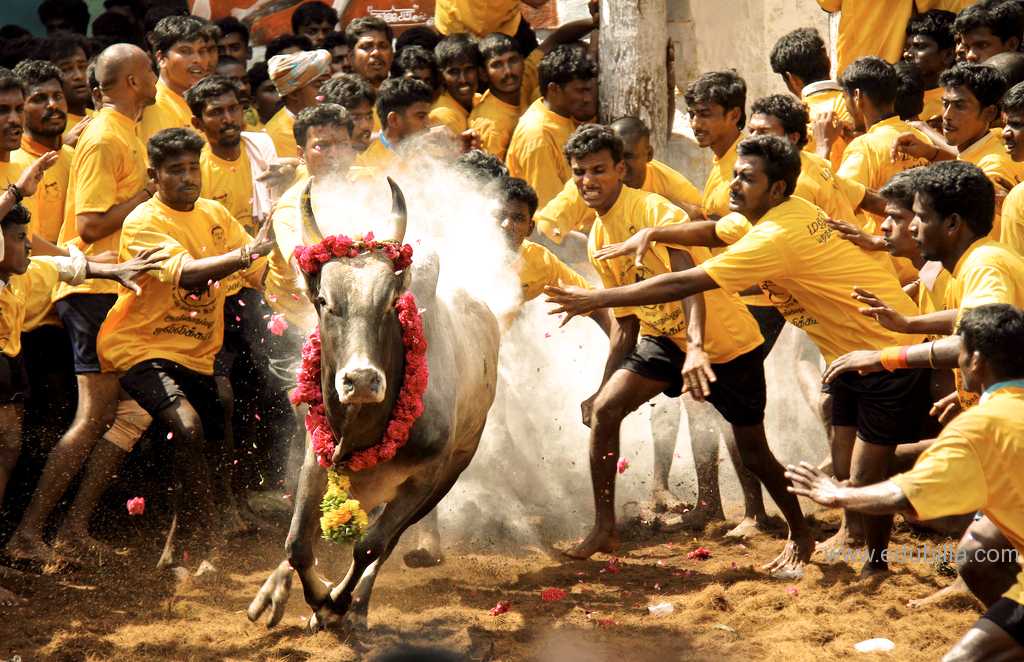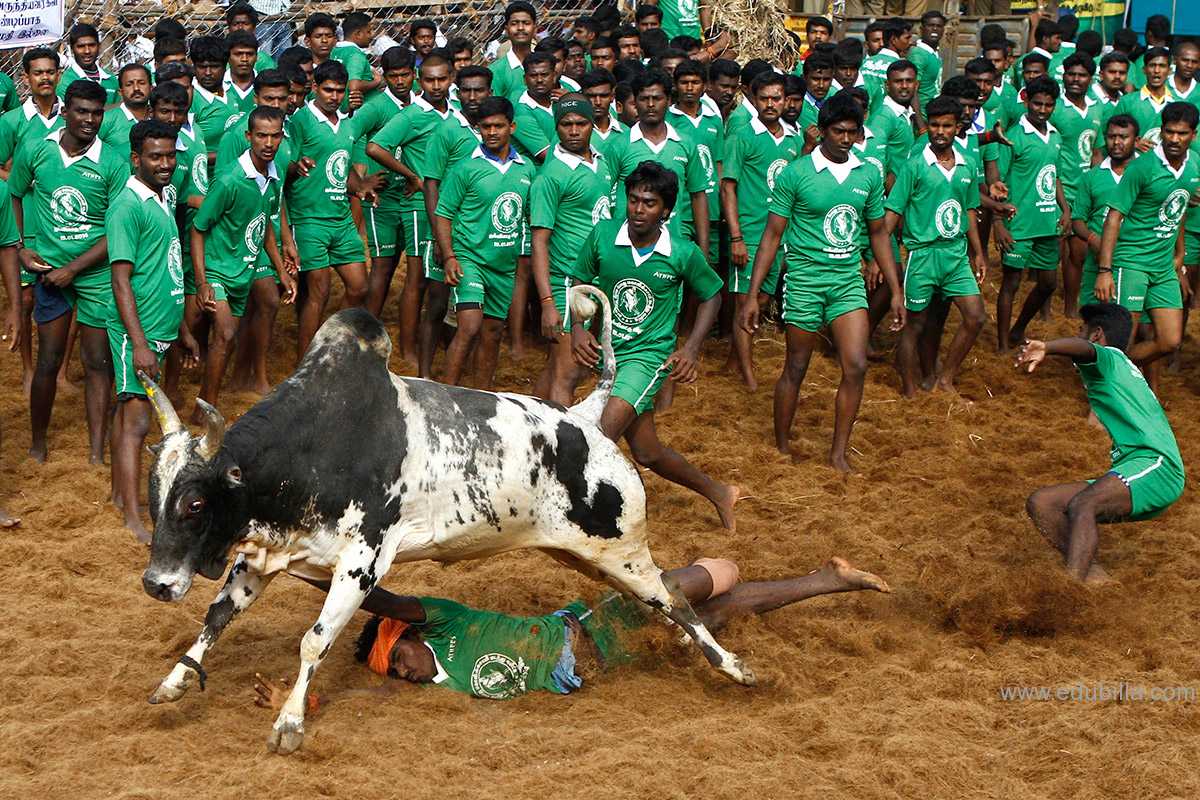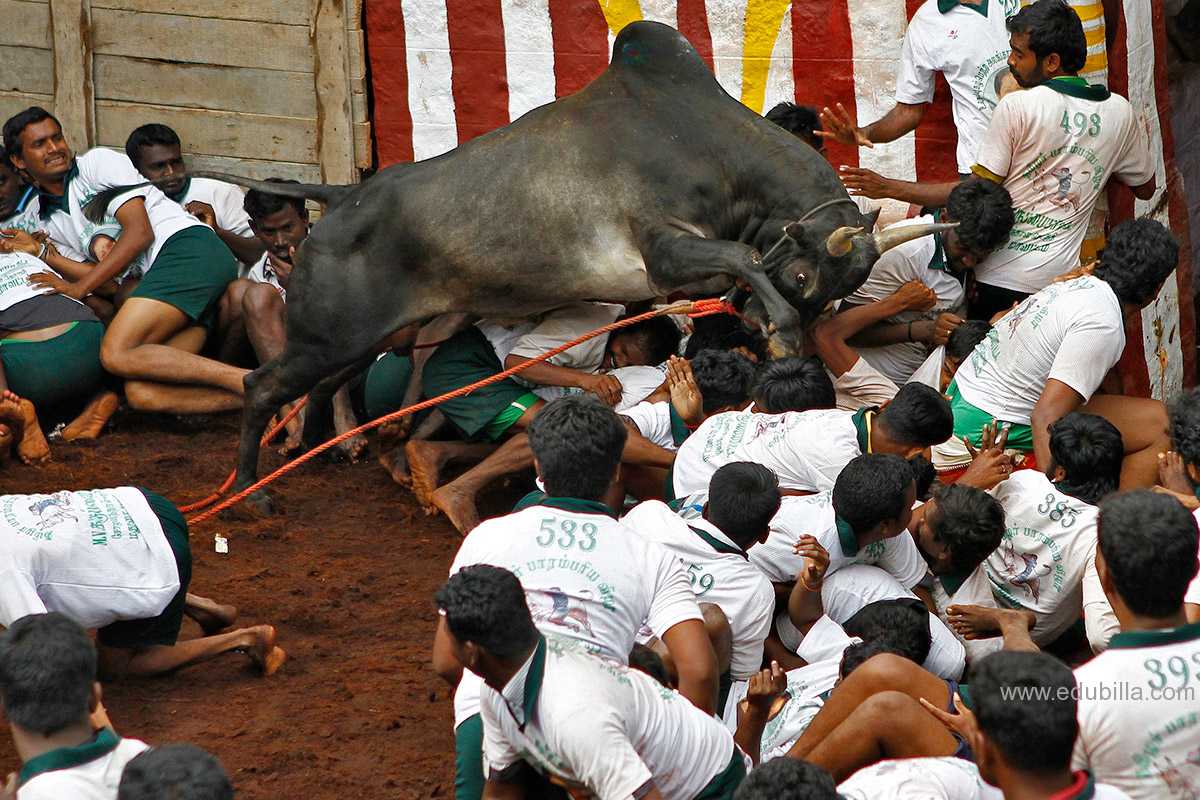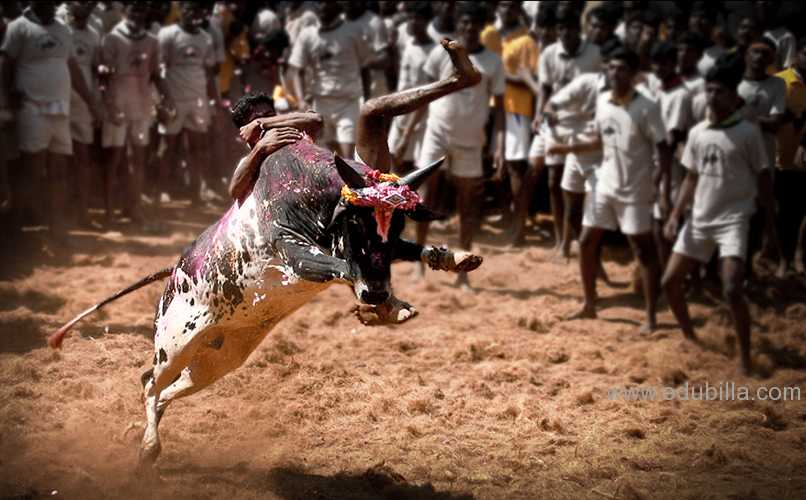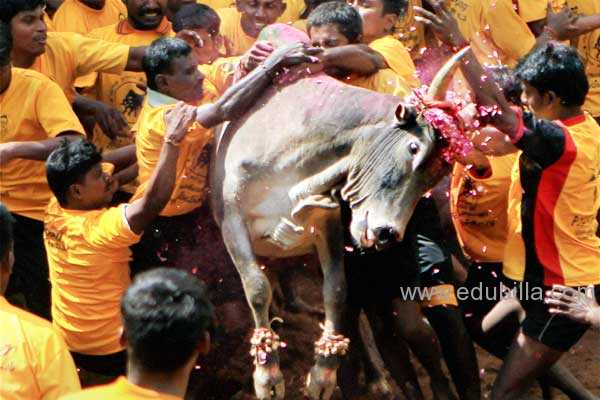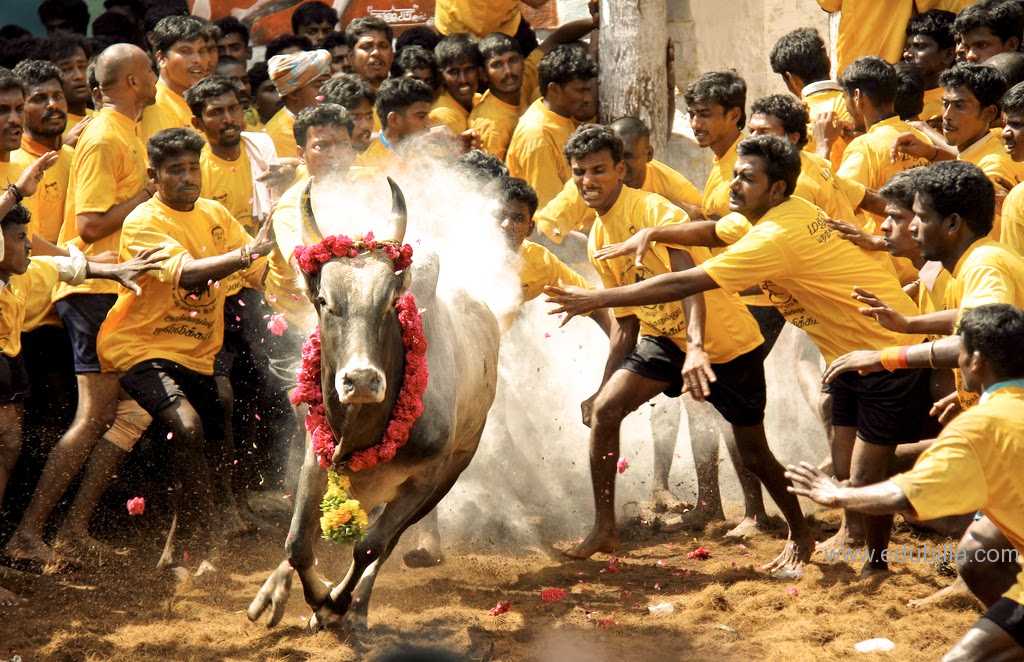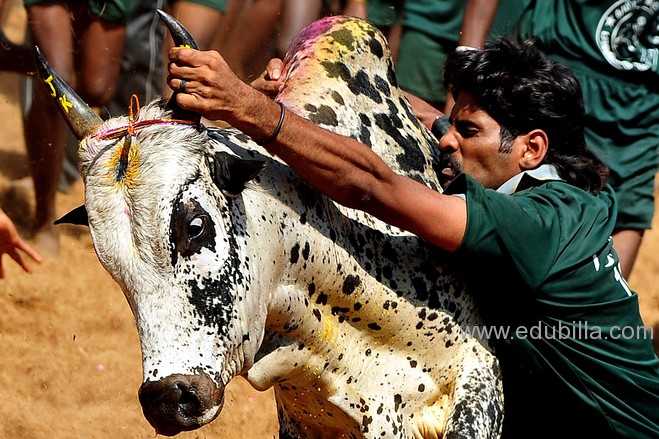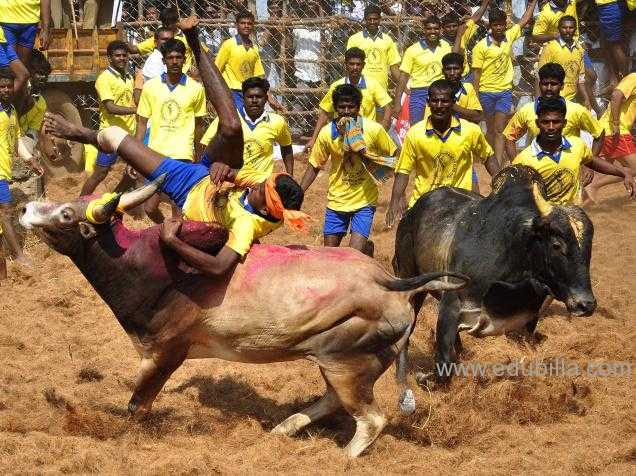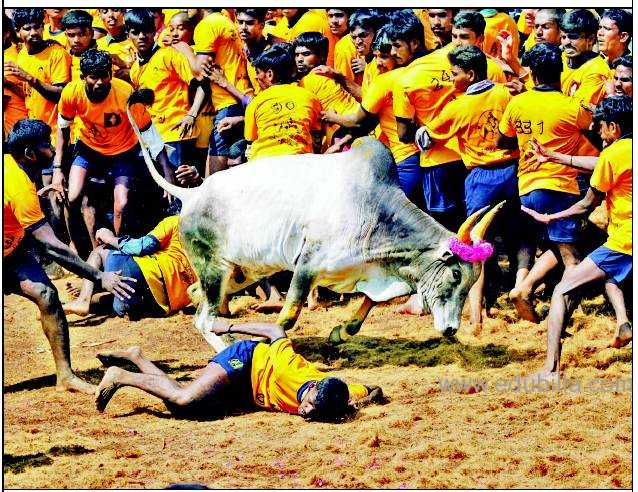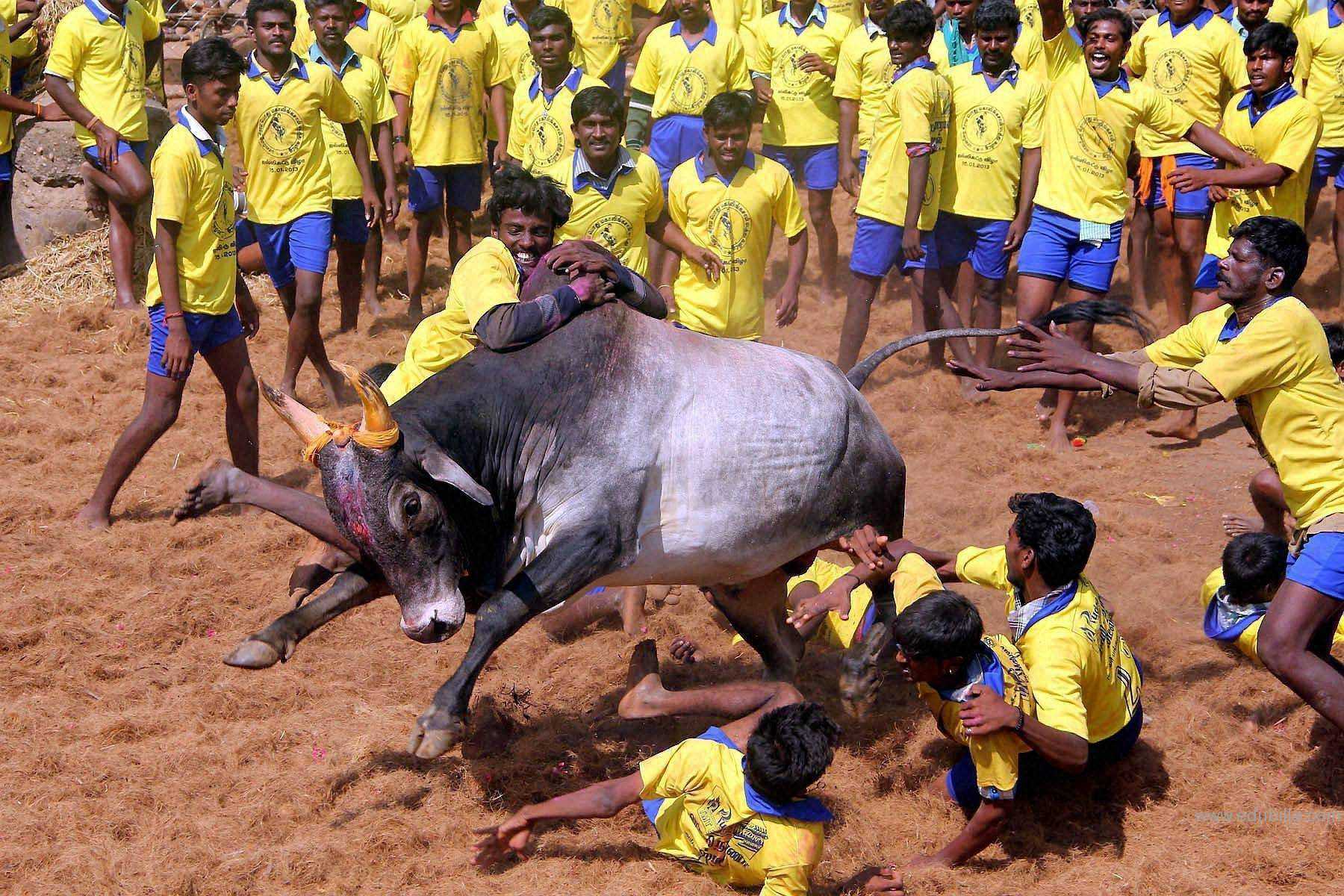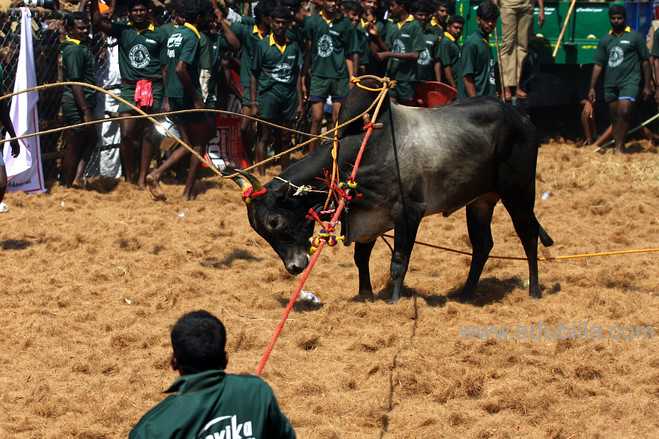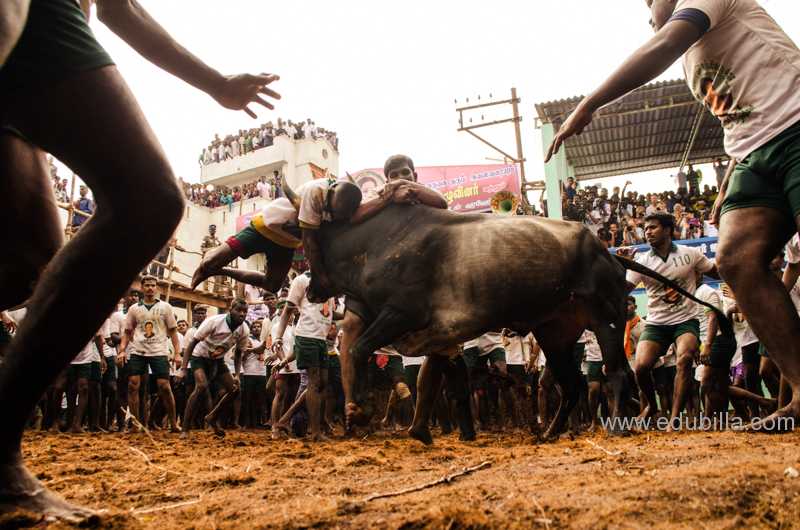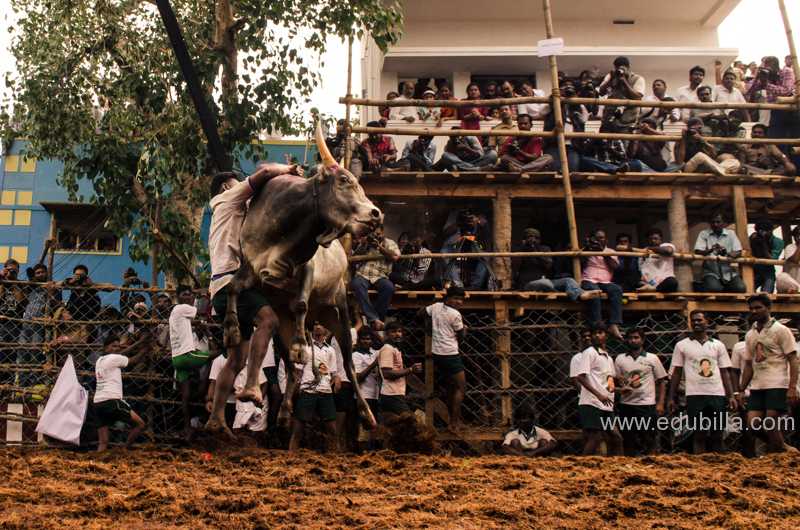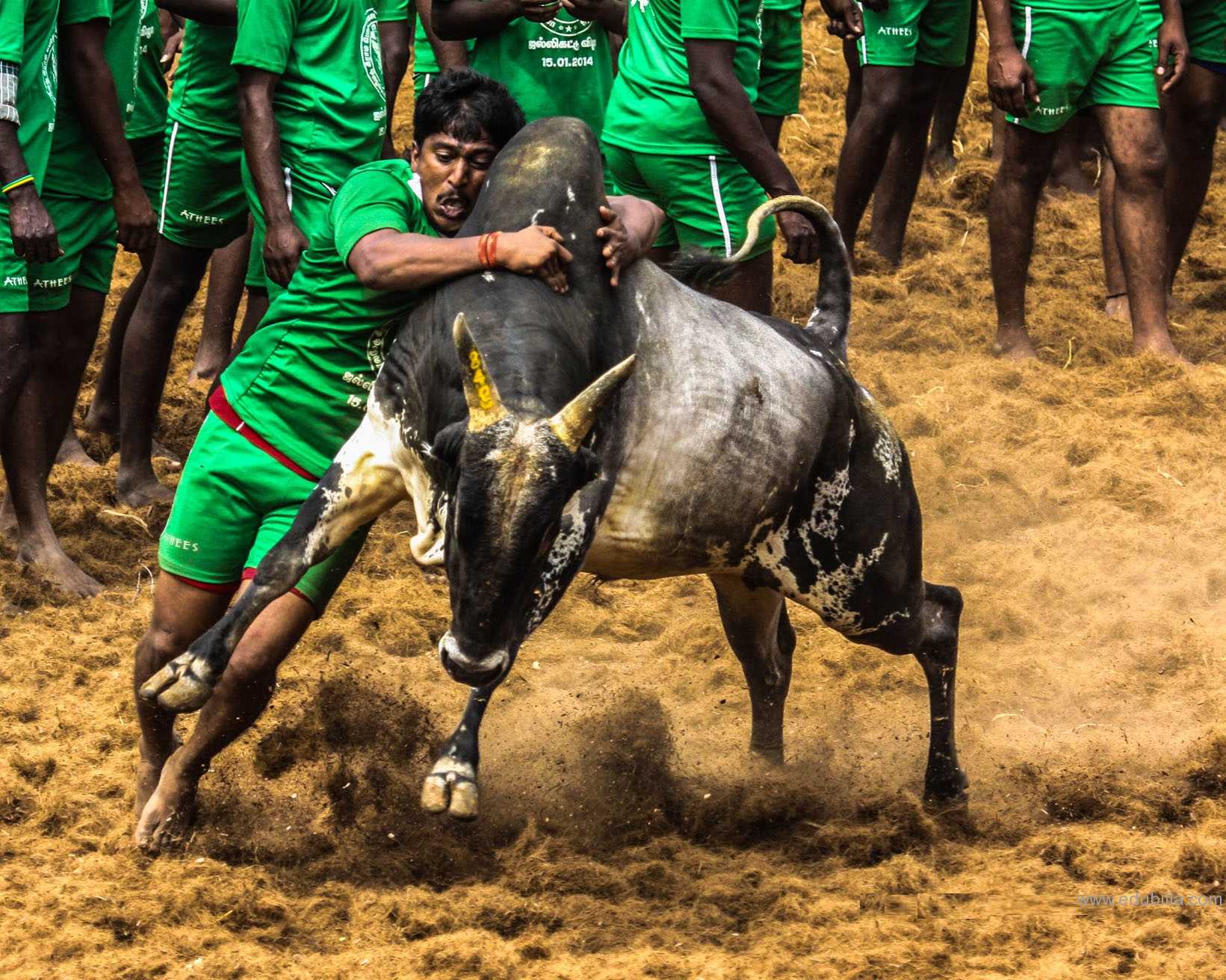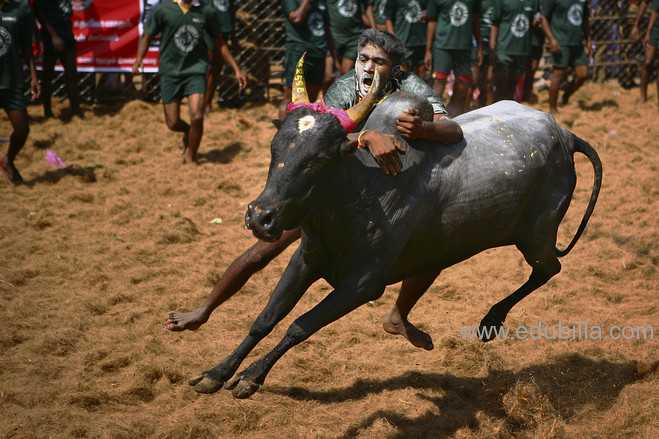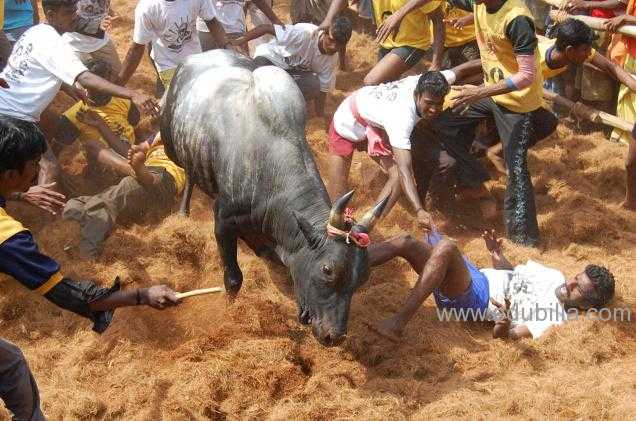
Overview Of Jallikattu
Jallikattu also known Eruthazhuvuthal or Manju viratu is a bull-vaulting event practised in Tamil Nadu as a part of Pongal celebrations on Mattu Pongal day. Bulls are bred specifically by some private rich persons of the village for the event and attended mainly by many villages' temple bulls (kovil kaalai). A temple bull is like the head of all cattle in a village; special rituals will be performed for this temple bull during important days.
Injuries and Deaths:
Jallikattu has been known to be practised during the Tamil classical period.It was common among the ancient tribes who lived in the ‘Mullai’ geographical division of the ancient Tamil country.The event often results in major injuries and deaths with over 200 deaths over the past two decades.Animal activists and PETA India have protested against the practice over the years.Along with human injuries and fatalities, the bulls themselves often sustain serious injuries.
Government:
In May 2014, the Supreme Court of India banned the practice, citing animal welfare issues.On 8 January, 2016, the Government of India passed an order exempting Jallikattu from all performances where bulls can not be used, effectively reversing the ban.However, on 14 January, 2016, the Supreme Court of India upheld its ban on the event, leading to protests all over Tamil Nadu.
Jallikattu Cattle Breeds:
There are 7 types of cattle breeds used for Jallikattu, which are native to their region. They are
- Kangeyam
- Puliyakulam
- Tiruchengodu
- Bargur or Semmarai
- Palamalai
- Umbalachery
- Alambadi
- Palamalai and Alambadi cattle breeds are on the verge on extinction.
There are three versions of jallikattu:
1)Vadi Manju Virattu - This version takes place mostly in the districts of madurai, pudukottai, theni, tanjore and salem. This version that has been popularised by television and movies involves the bull being released from an enclosure with an opening. As the bull comes out of the enclosure, one person clings to the hump of the bull. The bull in its attempt to shake him off will bolt (as in most cases), but some will hook the guy with their horns and throw him off. The rules specify that the person has to hold on to the running bull for a predetermined distance to win the prize. In this version, only one person is supposed to attempt catching the bull. But this rule being strictly enforced depends on the village where the event is conducted and more importantly, the bull himself. Some bulls acquire a reputation and that alone is enough for them to be given a unhindered passage out of the enclosure and arena.
2)Vaeli Virattu - This version is more popular in the districts of sivagangai, manamadurai and madurai. The bull is released in an open ground without any restrictions in any way (no rope or determined path). The bulls once released just run away from the field in any direction that they prefer. Most don’t even come close to any human. But there are a few bulls that don’t run but stand their ground and attack anyone who tries to come near them. These bulls will "play" for some time (from a few minutes to a couple of hours) providing a spectacle for viewers, players and owners alike. The magnificence of such bulls cannot be described. They must be seen firsthand to really understand the basic psyche behind the sport of jallikattu.
3)Vadam Manjuvirattu - "vadam" means rope in tamil. The bull is tied to a 50 ft long rope and is free to move within this space. A team of 7 or 9 members must attempt to subdue the bull within 30 minutes. This version is very safe for spectators as the bull is tied and great the spectators are shielded by barricades.
Training of jallikattu bulls:
The calves that are chosen to become jallikattu bulls are fed a nutritious diet so that they develop into strong, sturdy beasts. The bulls are made to swim for exercise. The calves, once they reach adolescence are taken to small jallikattu events to familiarize them with the atmosphere. Specific training is given to vadam manju virattu bulls to understand the restraints of the rope. Apart from this, no other training is provided to jallikattu bulls. Once the bulls are released, then instinct takes over.
Famous Jallikattu locations include:
- Alanganallur
- Avaniapuram
- Tiruvapur near Pudukottai
- Kondalaampatti, Thammampatti in Salem, Tamil Nadu
- Palemedu near Madurai
- Sravayal near Karaikudi
- Kanduppatti near Sivagangai
- Venthanpatti near Ponnamaravathy, Pudukottai (Dist)
- Pallavarayanpatty near Cumbum
Game Rules
- The Bull will be released on the the arena through the entry gate called ‘ Vadivasal’.
- The bull tamer / contestant should try to ‘catch’ the bull by holding onto its hump only.
- The bull-tamer should hold onto the bull till it crosses the ‘finish’ line. (Usually it is about 50 feet, marked by hanging overhead marker flags along the line.)
- If the bull throws the tamer off before the line or if no-one manages to hold on to the bull, then the bull will be declared victorious.
- If the bull-tamer manages to hold on to the hump till it crosses the ‘finish line’, then the bull tamer is declared the winner.
- Only one bull tamer should hold on to the bull at one time. If more than one bull tamers hold on to the bull, then there is no winner.
- The bull tamer should ONLY hold on to the hump. He should NOT hold on to the neck or horns or tails of the bull. Such tamers will be disqualifies.
- No bull tamer will hit or hurt the bull in any manner.
General Regulations for organising Jallikattu
- Jallikattu shall be permitted ONLY during the months of January to May every year.
- The Venue has to be approved by the District Collector.
Regulations for Organisers
Every person who organises the event shall,—
- take all precautionary steps for the orderly conduct of the event;
- inform in writing to the Collector thirty days prior to the date of the event and obtain his permission;
- double-barricade the arena or the way through which the bulls pass through, in order to avoid injuries to the spectators and by-standers who may be permitted to remain within the barricades;
- fix up the gallery for the spectators to sit and watch the event and the gallery shall be made up with strong sticks to permit occupation;
- arrange to obtain prior permission of the Collector to the persons, who wish to bring their bulls to participate in the event;
- ensure that the bulls are put to proper testing by the authorities of the Animal Husbandary Department to ensure that performance enhancement drugs are not administered to the bulls in any form and shall obtain a certificate to this effect in such form and in such manner as may be prescribed;
- arrange to enroll the names and other particulars of the bull tamers in the event with the Collector at least fifteen days prior to the holding of the event and the bull tamers shall also be put to thorough check up by a medical team constituted by the Collector for this purpose;
- ensure that every bull tamer to wear an exclusive dress for the sake of identification with necessary identification card issued by the Collector;
- deposit with the Collector, a sum as may be determined by the Collector, which shall not be less than rupees two lakhs, for the benefit of the victim including the members of the family of the victim in case of accident or injury during the event
BULL TAMERS
- Only pre-registered bull tamers will be allowed to participate
- All bull tamers have to be in the age group of 21 to 40 years
- Bull tamers will be tested for medical fitness
- Before entering the venue, bull-tamers will be tested for alcohol consumption etc
- All bull tamers should be provided an exclusive dress for the event and only whose wearing the dress will be allowd to enter the arena
- The contestants should hold on to the hump only.
- The contestants holding onto the horns, tail or neck of the bull will be disqualified
BULLS
- All bulls have to be pre-registered
- All bulls should carry recent medical fitness test certificate
- The horns of all bulls will be ‘blunted’ before the event entry
- The bulls will be tested for consumption of alcohol etc
- The bull should not be tortured or ill-treated in any manner
- No injured bull will be allowed into the arena
Equipments Need For Jallikattu
Jallikattu Bulls
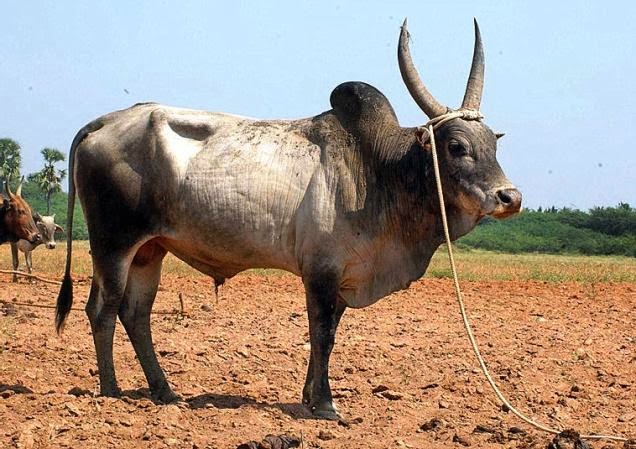
History Of Jallikattu
‘Jallikattu’ is a rare sport that has been continuously played for thousands of years. A seal made of stone found at Mohenjodaro, depicts “jallikattu” that was prevalent in the Indus Civilisation. The seal, about 4,000 years old, is on display at the National Museum, New Delhi.
The Sport has become an intrinsic part of the Tamil culture that it has broken all religious and caste barriers. People of all religions, caste and creed participate in this sport. The sport is usually held once a year in a village to celebrate a local temple or church festival. About 30% of the events held during 2013 were organised by christian churches.
Origin Of Jallikattu
Jallikattu, which is bull-baiting or bull fighting, is an ancient Tamilian tradition, popular amongst warriors during the Tamil classical period. According to legend, in olden days the game was used by women to choose their husbands. Successful "matadors" were chosen as grooms.
WHY DURING PONGAL
On 3rd day of the four-day-harvest festival, people offer prayers to bulls, cows and other farm animals and then play the customary bull-taming sport. They believe that not playing the sport will displease local deities, including lord Muniswara.
Etymology:
The term Jallikattu comes from the term "Salli" kassu (coins) and "Kattu" (meaning a package) tied to the horns of the bulls as the prize money. Later days during the colonial period this term got changed to Jallikattu which is the term currently used. Usually the majestic Kangeyam bull is involved in this game, as they are naturally more ferocious and muscular than any other of its species.
Governing Bodies
Awards Related To Jallikattu
The Bulls in Jallikattu game are very energetic and bold. The Bulls in this game come from all over Tamil nadu every year. The Kangayam Kaalai is a type of Bull which forms of the majority breed in this game. During this game, the bull will be released from a small zone to a public place triggered and irritated to its best level to maximize its anger and speed. The competing people try to control the bull and also try to bring them under their control. Once the bull comes under the control of a person, the erson will be declared as a winner. Special awards and prizes allocated for this Jallikattu game will be given to him. In Some places, the Prize money is tied in the bull’s horn. and the Challenge is for the players to take away the prize from the bull’s horn.
Sample Documents Of Jallikattu
-Lance Armstrong



